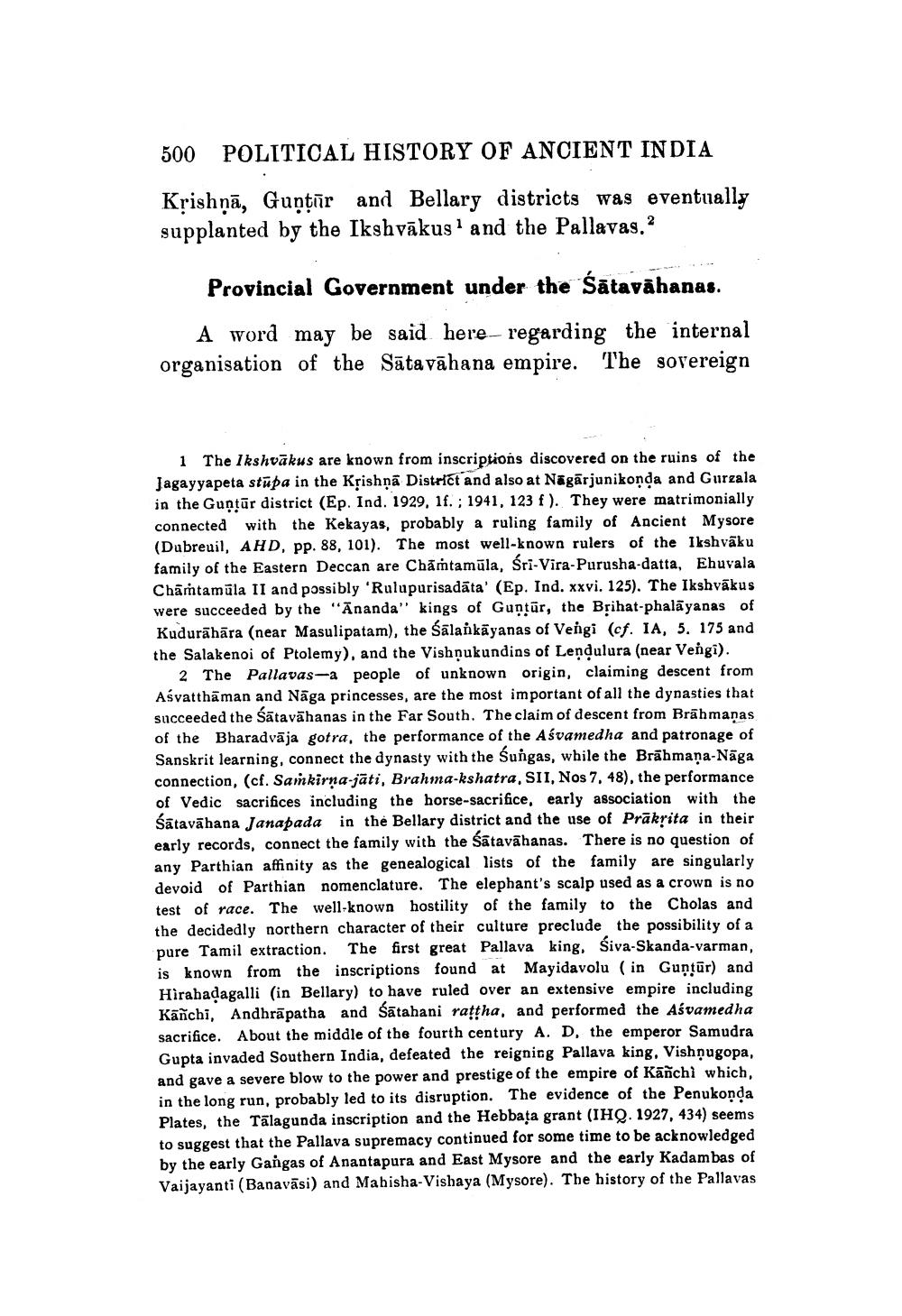________________
500 POLITICAL HISTORY OF ANCIENT INDIA Krishṇā, Guņtār and Bellary districts was eventually supplanted by the Ikshvākusand the Pallavas.?
Provincial Government under the Šātavāhanas.
A word may be said here, regarding the internal organisation of the Sāta vāhana empire. The sovereign
1 The Ikshvākus are known from inscriptions discovered on the ruins of the Jagayyapeta stupa in the Kțishņā District and also at Nāgārjunikonda and Gurzala in the Guntūr district (Ep. Ind. 1929, 1f. ; 1941, 123f). They were matrimonially connected with the Kekayas, probably a ruling family of Ancient Mysore (Dubreuil, AHD, pp. 88, 101). The most well-known rulers of the Iksh vāku family of the Eastern Deccan are Chāṁtamūla, Sri-Vira-Purusha-datta, Ehuvala Chämtamāla II and possibly 'Rulupurisadāta' (Ep. Ind. xxvi. 125). The Ikshvākus were succeeded by the "Ananda" kings of Guntūr, the Brihat-phalāyanas of Kudurāhāra (near Masulipatam), the Sālankāyanas of Vengi (cf. IA, 5. 175 and the Salakenoi of Ptolemy), and the Vishņukundins of Lendulura (near Vengi).
2 The Pallavas-a people of unknown origin, claiming descent from Aśvatthāman and Nāga princesses, are the most important of all the dynasties that succeeded the Satavahanas in the Far South. The claim of descent from Brāhmanas of the Bharadvāja gotra, the performance of the Aśvamedha and patronage of Sanskrit learning, connect the dynasty with the Sungas, while the Brāhmana-Näga connection, (cf. Samkirna-jāti, Brahma-kshatra, SII, Nos 7, 48), the performance of Vedic sacrifices including the horse-sacrifice, early association with the śātavāhana Janapada in the Bellary district and the use of Prākrita in their early records, connect the family with the sātavāhanas. There is no question of any Parthian affinity as the genealogical lists of the family are singularly devoid of Parthian nomenclature. The elephant's scalp used as a crown is no test of race. The well-known hostility of the family to the Cholas and the decidedly northern character of their culture preclude the possibility of a pure Tamil extraction. The first great Pallava king. Siva-Skanda-varman, is known from the inscriptions found at Mayidavolu ( in Guntūr) and Hirahadagalli (in Bellary) to have ruled over an extensive empire including Kanchi, Andhrāpatha and Sātahani rattha, and performed the Aśvamedha sacrifice. About the middle of the fourth century A. D. the emperor Samudra Gupta invaded Southern India, defeated the reigning Pallava king. Vishnugopa, and gave a severe blow to the power and prestige of the empire of Kanchi which, in the long run, probably led to its disruption. The evidence of the Penukonda Plates, the Tālagunda inscription and the Hebbața grant (IHQ. 1927, 434) seems to suggest that the Pallava supremacy continued for some time to be acknowledged by the early Gangas of Anantapura and East Mysore and the early Kadambas of Vaijayanti (Banavāsi) and Mahisha-Vishaya (Mysore). The history of the Pallavas




